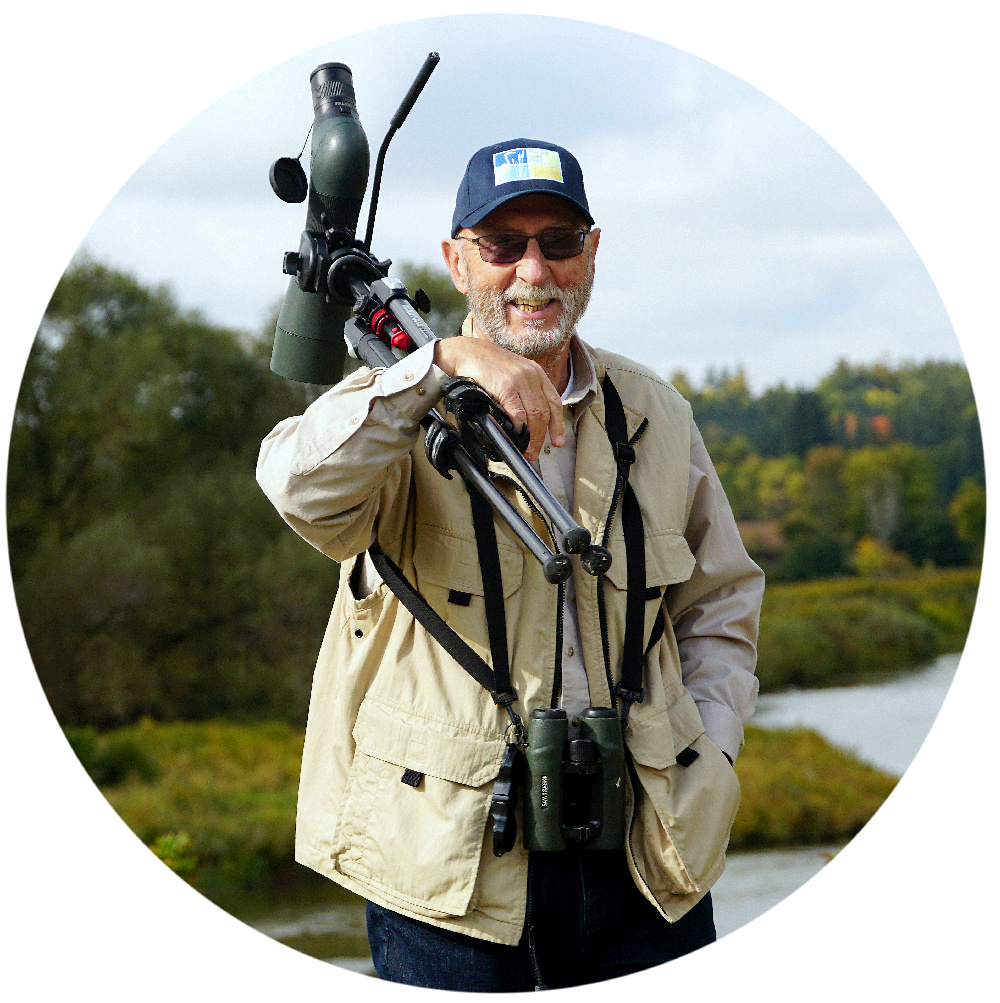There is a robust population of breeding Western Ospreys Pandion haliaetus in this area, many of whom have now left for their southern wintering haunts. Some juveniles, still dependent on their parents to provide food, still remain however, with at least one dutiful parent staying to make sure its offspring is provisioned.
I have been watching this young bird for several days and when I see it in the early morning it calls incessantly, begging for food.
The adult (I believe it is a male) perches on a distant snag, usually with a fish in its talons, quite visible I am sure to the agitated and hungry youngster.
This morning there was a strange twist to the usual sequence of events. A Turkey Vulture Cathartes aura glided in and seemed to buzz the osprey. The deliberate intent of the vulture became clear as it repeated the action, and the osprey became extremely agitated and screamed and flapped vigorously, food forgotten for the moment it seemed. The Turkey Vulture kept up its harassment until the osprey had had enough and launched itself into the air and attacked the vulture. No longer able to crest on thermals the vulture had to resort to flapping flight and was clearly no match for the aerial agility of the osprey. It was soon seen off.
It was a great show to watch, but I was left puzzled by it, since neither bird represented any threat to the other.
Perhaps the adult was pleased with its offspring for minutes later it delivered a fish.
Soon the parent will leave and head south, leaving the young bird to start to catch its own food and migrate alone. The most difficult part of its young life is about to begin.
In the river a Double-crested Cormorant Phalacrocorax auritus was drying its wings; as the weather gets colder this species too will leave our area.
There is always a nice variety of species in the various wetlands around here and this scene looks especially tranquil with a number of species taking advantage of the rich source of food the wetland provides.
On 19 August I took this picture of Common Cattail Typha latifola.
Now, the flower head is popping open and fluffy seeds are dispersed by the wind, or carried by water, to new locations.
Numerous Viceroys Limenitis archippus were flitting about in the meadow, mainly patronizing Goldenrod as this picture shows.
Viceroys mimic the similarly marked Monarch Danaus plexippus as an anti-predator strategy. Monarchs are toxic to birds and are therefore left alone. Viceroys benefit from looking enough like a Monarch that birds pass them by too.
Subscribe to:
Post Comments (Atom)
Land Acknowledgement
We acknowledge that the land on which we are situated are the lands traditionally used by the Haudenosaunee, Anishinaabe, and Neutral People. We also acknowledge the enduring presence and deep traditional knowledge, laws, and philosophies of the Indigenous Peoples with whom we share this land today. We are all treaty people with a responsibility to honour all our relations.
Followers
Welcome

My name is David. I'm a lifelong birder, fiercely committed to all of nature, however. Married to Miriam Bauman. I love to travel. I Enjoy a good book and a good glass of wine. To read more about me, click my ABOUT page.
Follow by Email
Search This Blog
Blog Archive
Popular Posts
-
I am quite confident in my judgement when I say that nuthatches (Family Sittidae ), small birds with a remarkable ability to scurry dow...
-
22 November, 2025 Leader: David M. Gascoigne Participants: Farid Asey, Heela Asey, Mina Asey, Palwasha Asey, Sameer Asey, Mary Ann Cassidy, ...
-
It has been a long time since I received those annoying, “Fail to publish, please try again later,” notices, but it is happening aga...
-
02 November, 2025 We had been invited to take a stroll though Laurel Creek C.A. with good friends, Dave and Mary, followed by coffee ...
-
29 November, 2025 After a snowy overnight, with everywhere white and glistening, it was a perfect day for an outing with our little Pri...
-
23 October, 2025 Predictably, Mallards ( Anas platyrynchos ) were easily found. You will note just left of centre in the picture...
-
I just returned from a successful and highly enjoyable visit to Colombia with birding friends. We'll all have very fond memories fo...
-
Mere days ago I was having a discussion with a friend about the exclusion of women from so many aspects of society in certain parts o...
-
Of late, there seems to be more and more involved with posting a comment to some blogs, not all by any means, but enough! It is ...
-
As I continue to be afforded the great pleasure of leading outings for Waterloo Region Nature, I am offering two options for local de...


























I should copy the butterfly's strategy by shaving my head and getting some prison tatoos done................
ReplyDeleteI guess that means we have 'Eastern' Osprey in Japan? I've seen Osprey in Scotland, does that mean I've just got an anmchair lifer?
Eastern Osprey is found in Australia.
DeleteIt's OK, I saw one in Queensland, in 1994!!
DeleteBonjour cher ami,
ReplyDeleteJ'ai été très captivée par votre récit... Les animaux nous donnent de belles leçons de vie. Il est tellement intéressant de les observer.
Vos photos sont magnifiques. Capturer un papillon où un oiseau n'est jamais très aisé.
Gros bisous ☼
Kalimera Mr G. I hope to see an Osprey fishing the clear blue waters of Skiathos however I fear I may be too late. Never mind I will content myself with Hobbies, Honey Buzzard and Eleanora's Falcons.
ReplyDeleteHello David, love that Osprey, one of my favorite birds. They must start their migration soon.The male bird is usaly the last one to go after the young ones have left.
ReplyDeleteRegards,
Roos
Must have been a wonderful sight,I love Ospreys,we normally get two or more moving through Cornwall.
ReplyDeleteWent out yesterday looking for them,no luck,will try again today.
John.
Pracht face large bird atop its nest.
ReplyDeleteBeautiful butterfly got you, I do not see this kind here.
Greetings Tinie
Awesome collection of photos and wonderful birds. I love the Osprey shots. Enjoy your day!
ReplyDeleteHandsome osprey, must have been quite a show. A nice series of shots.
ReplyDeleteGreat story David, these scenes are source of much info about species observations.
ReplyDeleteNature never ceases to amaze! Let's hope this youngster will manage well on his own, it is really time he fends for himself before the harsh days of winter!
The name of Viceroy butterfly is perfectly matched to its mimicry of the Monarch, a beautiful photo!
Fuertes abrazos para ti y Miriam!
Very interesting read about the Osprey, David. You're proposing what would be considered very unusual behaviour from a UK Osprey. It is normal for the adult male to stay until the very last juvenile has left, before heading south himself. There have now been 102 chicks fledged from Rutland Water since the reintroduction programme began. I'm not aware that any of those birds have been left unattended prior to migration! There have been times, however, when we've wondered if the adult would give up waiting on a late-departing juvenile!
ReplyDeleteI wasn't aware that the Monarch had such an accomplished mimic! I checked one against the other, and found myself thinking that it was like looking at a kids 'spot the difference' puzzle!
A great post!
Best wishes to you both - - - - Richard
Hi Richard: Based on your comment and that of Roos above I checked my references and the information given above is correct, viz, adults do precede juveniles, see Billdstein, K.L. "Migrating Raptors of the World" for example. Perhaps the intense human intervention with the Rutland Ospreys has something to do with this difference in behaviour between British Ospreys and North American birds, which, other than the provision of nesting platforms, receive no assistance from humans.
DeleteI wouldn't say that the Rutland Ospreys receive intense human intervention, David! We provide nesting platforms, as happens in North America. Other than that, the only other intervention is ringing of the chicks, and preventing intrusion. On very rare occasions (I can think of only one) we provide vetinary attention to a wounded chick. Once only, as far as I am aware, for a short period of time we provided fish to a female Osprey with eggs when her partner perished. However this didn't work so will probably not be repeated.
DeleteDear David,
ReplyDeleteWhat an incredible story and it sure leaves you pondering about the Turkey vulture's motive... Love your photos and also the Common Cattail did bring back fond childhood memories as we had many of those in our immediate neighborhood.
Hugs from Georgia/USA,
Mariette
Hello David, Ospreys are very important in your life I suppose.
ReplyDeleteIt took me some time before I knew that David Gascoigne wasn't a nickname for Theo Spreynest! ;-)
But looking at these pictures makes it all clear! What a beautiful bird it is.
Gr Jan W
Theo Spreynest! That's pretty good, Jan.
DeleteOh yes, the Osprey is beautiful, and you caught it very well. Brilliant David.
ReplyDeleteOspreys are such fun to watch!
ReplyDeleteGreat photos David.
ReplyDeleteThe Osprey is really great.
All perfectly photographed, my compliments.
Best regards, Irma
The Osprey is a beautiful bird to see. In the Netherlands there are only a few and one of them also is not so far away. Beautiful photos of your osprey. The heron and cormorants are also beautiful photo provided elsewhere. Reed Cigars (sun we always call them) are very photogenic :-))))
ReplyDeleteI saw an Eastern Osprey this weekend! Nice (and very similar) bird!
ReplyDeleteCheers - Stewart M - Melbourne